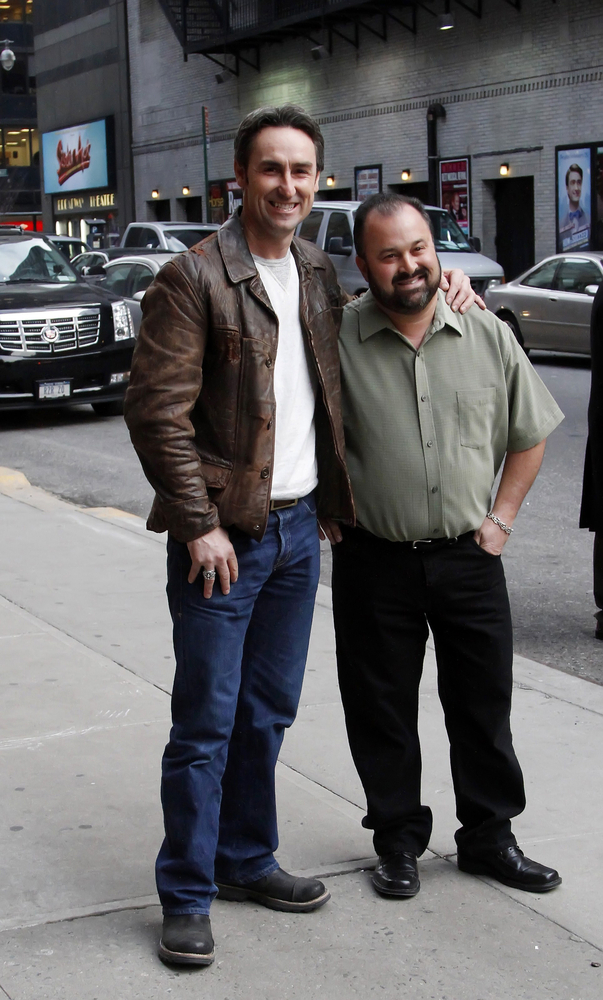Fans are devastated at the news that Frank Fritz, the antiques expert who gained fame on the reality series American Pickers, has died at 60.
Fritz, who left the series in 2021, had been suffering from health problems and was hospitalized from a stroke two years ago.

The news was announced by Fritz’s friend and co-star Mike Wolfe, who said that Fritz passed away last night.
“I’ve know Frank for more [than] half my life and what you’ve seen on TV has always been what I have seen, a dreamer who was just as sensitive as he was funny,” Wolfe wrote in a social media tribute. “The same off camera as he was on, Frank had a way of reaching the hearts of so many by just being himself.”
Fritz and Wolfe gained fame as the hosts of the reality TV series American Pickers, which premiered on the History Channel in 2010. The series showed the two “pickers” traveling across the USA, searching for valuable antiques and collectibles in unexpected places.

“We’re looking for amazing things buried in people’s garages and barns,” the show’s opening narration explains. “What most people see as junk, we see as dollar signs. We’ll buy anything we think we can make a buck on.”
“We make a living telling the history of America… one piece at a time.”
The series attracted millions of viewers, becoming one of History Channel’s most popular programs. In its debut year it was the #1 non-fiction series among total viewers and adults 25-54.
While the antiques were often interesting, there’s no doubt it was the chemistry and charisma of the two hosts that kept viewers coming back for more.

In 2021, it was announced that Fritz would be leaving American Pickers after a decade on the hit series. Fritz said the decision was not his own, and that he was pushed out by the network after a back surgery.
“I didn’t leave the show,” he told The Sun at the time. “I finished shooting and then I had a little back surgery and the pandemic came.”
He also suggested that his co-host’s ego was a factor, saying the show had “tilted towards him 1,000 percent.” “I haven’t talked to Mike in two years,” Fritz said. “He knew my back was messed up, but he didn’t call me up and ask how I was doing. That’s just how it is.”

In July 2022, Fritz was hospitalized from a stroke. In 2023, he had a tearful reunion with Mike Wolfe, and the two resolved their purported feud. However, Fritz declined an offer to rejoin American Pickers, deciding to focus on his health.
It’s clear that the two former co-hosts have remained friendly since then, and it seems Wolfe was by his side til the end.
“We’ve been on countless trips and shared so many miles and I feel blessed that I was there by his side when he took one last journey home,” Wolfe wrote on Instagram. “I love you buddy and will miss you so much I know [you’re] in a better place.”
American Pickers remains a staple of the History Channel lineup. Fritz has never officially been replaced as co-host, though series regulars like Danielle Colby, Mike Wolfe’s brother Robbie, and friend and antiques expert “Jersey Jon” Szalay will rotate accompanying Wolfe on his antiquing trips.
Colby also shared her own tribute to Fritz on social media. “Frank, I will miss your ability to make everyone laugh, your love for talking tattoos, your epic collections but what I will miss the most are those little glimpses of vulnerability from time to time,” she wrote.
“Frank, you loved your cat and your momma and we bonded on those things. You will be missed for all of these reasons and so many more.
Rest in Peace Road Dog.”
Rest in peace to the iconic reality TV star Frank Fritz 😢🙏 Please share this story in his memory.
My Daughter Kept Coming Home Later than Usual — What I Discovered Left Me Speechless

What a beautiful and poignant story, capturing the deep emotional journey of healing and reconnection. It truly resonates with the idea of second chances and how family can mean rediscovery, forgiveness, and understanding, even across generations. It’s powerful how you’ve woven the narrative around a child’s need for her father’s memory and the bond she finds in an unexpected place. Lila’s perspective and emotions are so tenderly portrayed, and the mother’s inner conflict and eventual empathy for Henry bring the story to life.
If you’re planning to expand on this, perhaps exploring Lila’s journey with Henry and how she processes her father’s legacy through her grandfather’s memories could add even more depth. This story strikes the perfect balance of sorrow and hope, and its message about family ties staying strong in unique ways is beautiful.



Leave a Reply